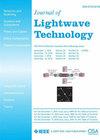Hidden Feature Extraction Learning and End-to-End Joint Equalization With LDPC Decoding Method for Optical Interconnect
IF 4.1
1区 工程技术
Q2 ENGINEERING, ELECTRICAL & ELECTRONIC
引用次数: 0
Abstract
The vertical-cavity surface-emitting lasers and multimode fiber (VCSEL-MMF) solution has successfully emerged in optical interconnects (OIs), which meets the challenges of signal impairments in ultra-high-speed scenarios. Deep learning (DL) techniques, which can approximate any nonlinear function, enable the design of communication systems by carrying out the optimization in a single end-to-end (E2E) process including the transceivers as well as communication channels. In this paper, we propose a hidden feature extraction learning method for neural network equalization to improve training efficiency without increasing computational burden. Superior bit error rate (BER) is demonstrated in achieving 288 Gb/s 100 m VCSEL-MMF interconnect compared with black-box training strategy. Furthermore, an E2E joint equalization and low-density parity-check (LDPC) decoding method is proposed to improve the overall performance. Based on the autoencoder (AE) architecture, the E2E network involves a digital pre-distorter (DPD), a digital optical link model, a feed forward equalizer (FFE) and a deep learning based Normalized Offset Min-Sum (DL-NOMS) LDPC decoder. Experimental results demonstrate that the BER performance of the proposed E2E scheme is two-magnitude lower than the E2E equalization and FFE+DL-NOMS decoding method in back-to-back (BTB) and 100 m VCSEL-MMF links.求助全文
约1分钟内获得全文
求助全文
来源期刊

Journal of Lightwave Technology
工程技术-工程:电子与电气
CiteScore
9.40
自引率
14.90%
发文量
936
审稿时长
3.9 months
期刊介绍:
The Journal of Lightwave Technology is comprised of original contributions, both regular papers and letters, covering work in all aspects of optical guided-wave science, technology, and engineering. Manuscripts are solicited which report original theoretical and/or experimental results which advance the technological base of guided-wave technology. Tutorial and review papers are by invitation only. Topics of interest include the following: fiber and cable technologies, active and passive guided-wave componentry (light sources, detectors, repeaters, switches, fiber sensors, etc.); integrated optics and optoelectronics; and systems, subsystems, new applications and unique field trials. System oriented manuscripts should be concerned with systems which perform a function not previously available, out-perform previously established systems, or represent enhancements in the state of the art in general.
 求助内容:
求助内容: 应助结果提醒方式:
应助结果提醒方式:


